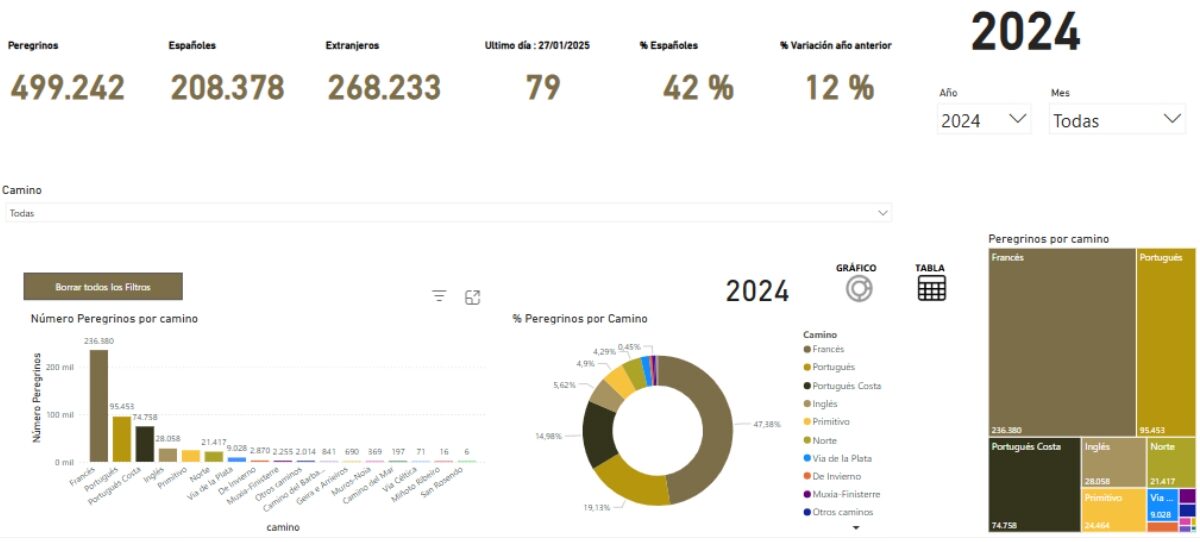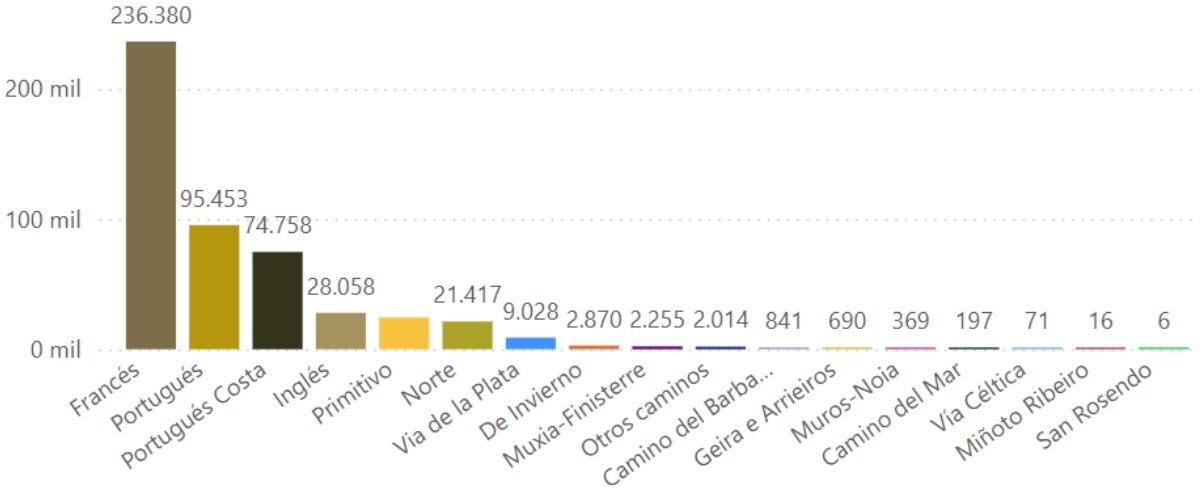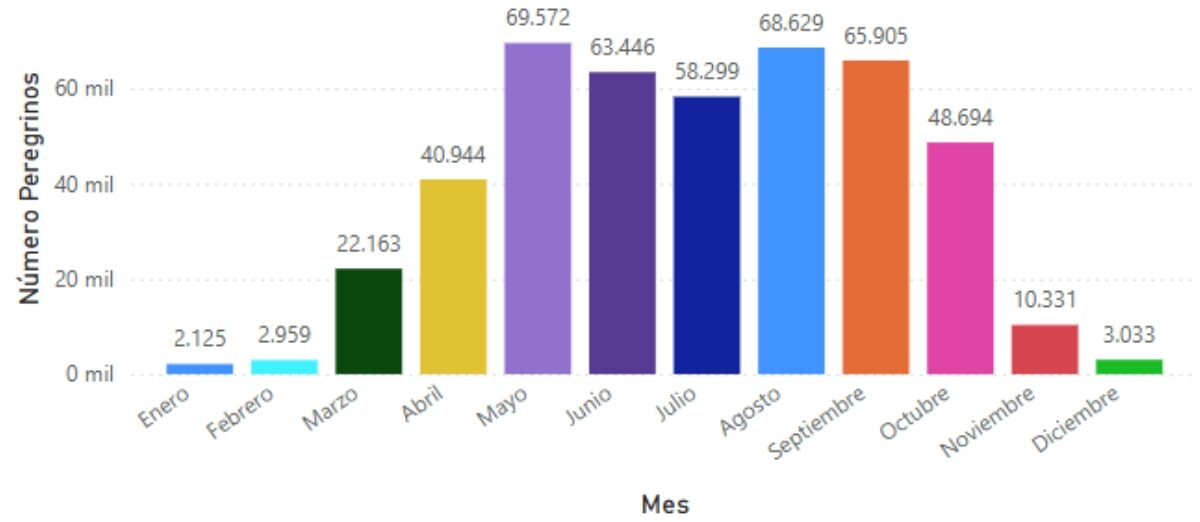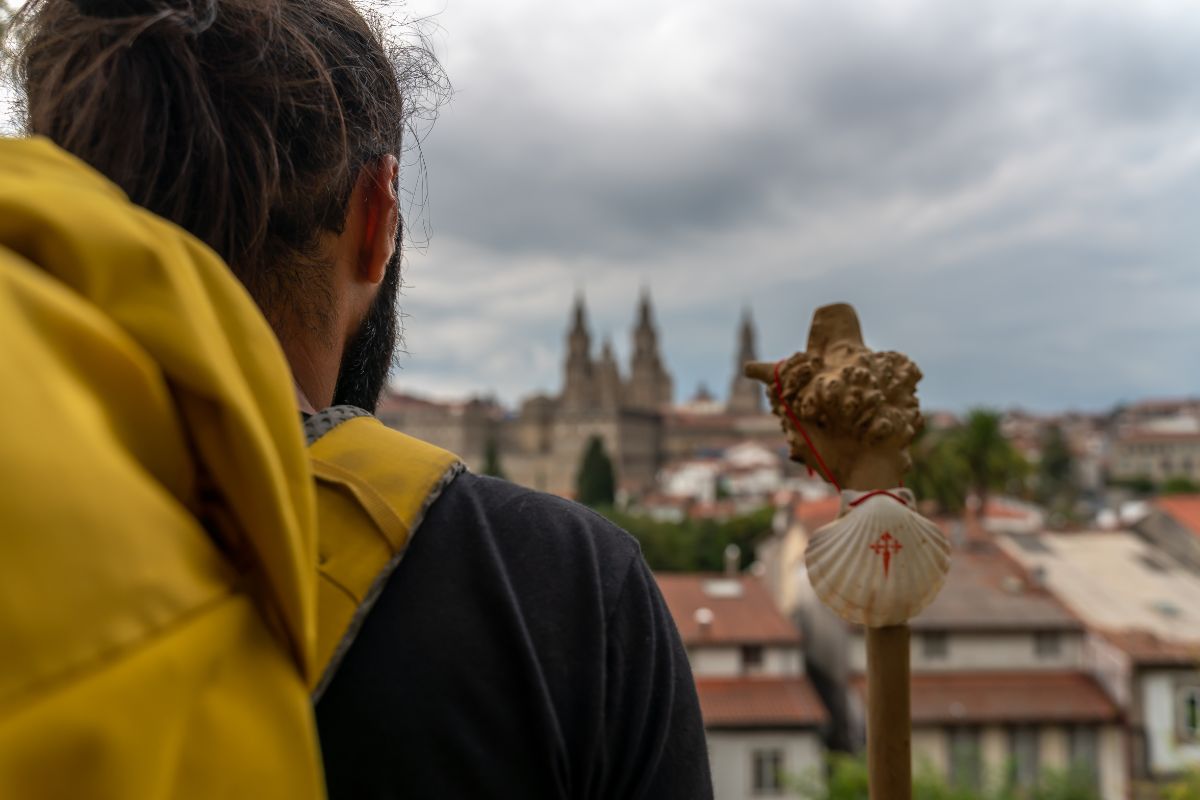- The Way of Saint James in Numbers in 2024
- Where were the pilgrims who walked the Camino from?
- Which Jacobean routes were the most popular?
- What are the favorite starting points for the Camino?
- Which months of the year had the most pilgrims?
- How did pilgrims travel to Santiago?
- What were the main motivations?
- Who walked the Camino more, women or men?
- And finally, what were the ages of the pilgrims?
- Highlights of the Camino statistics in 2024
As passionate as we are about the Jacobean universe, it’s time to take stock of how many pilgrims decided to walk the Camino de Santiago in 2024. In this article, we’ll analyze the statistics of the Camino from the past year: how many pilgrims reached Santiago, which routes are their favorites, where they’re from, and more. What the last year has left us on the different Jacobean routes tells us that the Camino de Santiago is very much alive. Keep reading, as we’ve got the 2024 Camino de Santiago numbers all ready for you.
The Way of Saint James in Numbers in 2024
To understand how the Camino performed in 2024, we refer to the provisional data provided by the Pilgrim Office of Santiago de Compostela. As you may know, this office is responsible for issuing the Compostela and gathering information from pilgrims who request it. On its website, it offers data on the Camino de Santiago from the year 2003. We’ve consulted it, and here’s the following overview of the Camino in numbers for 2024.

Statistics of the Camino de Santiago in 2024. Source: Pilgrim Office website of Santiago de Compostela
As can be seen, a total of 499,242 pilgrims arrived in Santiago in 2024 and requested the Compostela. It should be noted that not all pilgrims who reach Santiago request the Compostela, so the actual number is likely higher. Additionally, many pilgrims don’t even reach Santiago but only walk parts of the Camino.
Anyway, let’s get to the point. Below, we will take a detailed look at the statistics of the Camino de Santiago for the past year, 2024.
Where were the pilgrims who walked the Camino from?
Regarding the origin of the pilgrims, 42% of the pilgrims who arrived in Santiago in 2024 were Spanish, with a total of 208,378, making it the most represented nationality. Among Spanish regions, Andalusians lead the way with 49,172 pilgrims, followed by those from Madrid, Valencia, Catalonia, and Castilla-La Mancha.
The second most represented country on the Camino was the United States, with 38,052 pilgrims, almost 8%. They are followed by Italy (28,599), Germany (23,462), and Portugal (21,935). The total number of foreign pilgrims was 268,233, surpassing the number of Spanish pilgrims.
Which Jacobean routes were the most popular?
The top 3 preferred routes are led by the French Way, as has been the norm in recent years and throughout history. With 236,380 pilgrims, nearly half of the total, the number is not surprising, as it is perhaps the most beautiful, easiest, and most popular Jacobean route. It is followed by the Portuguese Way, with 95,453, and the Portuguese Coastal Way, with 74,758. The following table provides more details:

Statistics of the total number of pilgrims by route in 2024. Source: Pilgrim Office website of Santiago de Compostela
What are the favorite starting points for the Camino?
The town of Sarria in Lugo, with 151,091 pilgrims, is the preferred starting point for the Camino, accounting for over 30% of pilgrims. It is followed by Porto, with 49,715, making up more than 10%, as the starting point for both the historic Portuguese route and the Coastal route. Next is the city of Tui, with 36,576 pilgrims, representing just under 8%.
Which months of the year had the most pilgrims?
The most popular month for pilgrims is May, with 15% and a total of 69,572 pilgrims. The following months are next on the list:
- August, with another 15%;
- September, with 14%;
- June, with almost 14%;
- July, with almost 13%;
- October, with nearly 11%;
- April, just under 9%.
The figures for the months of November, December, January, February, and March together account for around 8%.

Statistics of the total number of pilgrims by month in 2024. Source: Pilgrim Office website of Santiago de Compostela
How did pilgrims travel to Santiago?
Walking the Camino is the preferred method for pilgrims to enjoy the journey: 425,045 pilgrims chose this, accounting for just over 93%. Nearly 5% of pilgrims traveled by bike. The numbers for pilgrims on horseback, by sail, and in wheelchairs are very low.
What were the main motivations?
Regarding the question of why people walk the Camino, a total of 215,977 pilgrims stated that they did so for religious reasons, making up just over 47%. The rest of the reasons were religious and others, accounting for a long 33%, and finally, non-religious reasons, with just over 19%.
Who walked the Camino more, women or men?
Girls are warriors, and very much pilgrims, and for some time now, women have made up the majority on the Jacobean routes. A total of 245,677 women walked the Camino, just over 53%, while 210,423 men walked it, making up just over 46%.
And finally, what were the ages of the pilgrims?
The Camino can be walked at any age, and in the three age groups analyzed, we find pilgrims. People aged between 46 and 65 stand out, with 184,904, representing just over 40%. Next are adults aged between 18 and 45, with just over 39%. Those over 65 account for more than 11%, and lastly, there are those under 18, with just over 8%.
Highlights of the Camino statistics in 2024
As we can see, the Camino is in excellent shape and progressing well, with a total increase of 12% in pilgrims compared to the previous year. The main takeaways from the Camino statistics can be summarized as follows:
- The significant 12% increase in pilgrims compared to the previous year;
- The French Way remains the most popular route;
- The significant growth of the Portuguese Coastal Way;
- The gradual rise in interest in other, lesser-known routes;
- The increased presence of foreign pilgrims, who are increasingly coming from all over the world.
Despite COVID-19 in 2020, the Camino made a strong recovery in 2021, as it became a safe and healthy outdoor holiday alternative. In 2022, thanks to Pope Francis’ declaration of an Extraordinary Holy Year, the recovery path stabilized with a new record.
In conclusion, 2024 has been a great year for pilgrims and confirms that the Camino is an experience that continues to attract more people. So, what is it about the Camino de Santiago? If you haven’t done it yet, don’t let others tell you about it. We can help you experience all the magic of walking the Camino de Santiago in 2025.












Leave A Comment